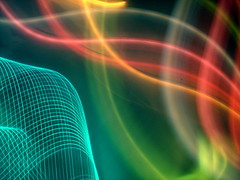 Pælm kameraet opp i lufta, sats på at en lyskilde i nærheten eksponerer et spennende mønster, ta imot kameraet før det faller i bakken, og vips ender du opp som dedikert kamerapælmer. Bortsett fra høy risiko og mange misslykkede bilder virker dette som god gammeldags moro.
Pælm kameraet opp i lufta, sats på at en lyskilde i nærheten eksponerer et spennende mønster, ta imot kameraet før det faller i bakken, og vips ender du opp som dedikert kamerapælmer. Bortsett fra høy risiko og mange misslykkede bilder virker dette som god gammeldags moro.Fine bilder blir det også (jmf. >>>).
Alle disse eksemplene finnes i artikkelen som introduserer "Camera tossing". Bildene er hentet fra Flickr hvor det finnes en mengde slike bilder, ved å klikke på dem kan du se større versjoner
Light Spirograph Effects (axis spin)
All night time camera tossing mostly in front of neon light sources. Style of throw was spinning on lens axis facing the subject.




Linear effects (end over end)
Flipping the camera end over end where the lens sweeps a partial rotation or more.




Intersecting Linear effects (chaotic throw)
Usually partially end over and but with some lop-sided aspect, maybe even some rotation mixed in. Generally a chaotic throw. The result is often the same light source streaking across the frame in different directions. Depending on exposure length this may happen several times.




Traversal effects
Some simple traversal and some with spin included. The camera moving across a subject has a wonderful ability to reveal texture if focus is spot on.




Short exposure and image warping...
My theory is that this is due to how the shutter or digital shutter intersects with the subject, when very fast spin is involved the combination yields a curve even if the subject was linear. This effect is separate from the motion blur that occurs. It also seems to vary greatly from camera to camera. These are the most pronounced examples...




Refresh rates and electrical cycle
Subjects that are electrical and use alternating current, or monitors that have certain refresh rates and scan lines, respectively reveal that property when camera motion is fast enough. Other types of camera motion or subject motion reveal this too, but it's one element that makes spirographic results so striking.




Simplicity and Structure of Toss
Simple subjects often reveal the structure of the toss. Pay close attention to your results and you can often picture how the camera was moving.




Generative Forms
Closely related to uniform spirographs, are the generative forms that appear as a subject overlaps itself one or more times during the motion of the camera. These are often quite striking and one of my favorite aspects of this technique.




Non-fluid anomolies
These are good examples of what happens when the exposure starts just before it leaves your hands. Some part of the image is not fluid and reveals the jumpy start.




Leaving the flash on
We don't have too many examples of this, but the results are often amusing!




Camera tossing self portraits
Definitely one of the most enjoyable activities to undertake. And this is all about having fun!




Subtle color and texture via motion
If your environment has interesting texture or color, you can often achieve wonderfully muted light paintings.




Revealing texture through motion
When you start to really take this seriously, you can zero in on just the texture of a subject, and wonderfully reveal it through the motion of the camera. As with many examples, these are definitely worth viewing LARGE.




Les hele artikkelen: Camera Toss, Mini-HOWTO.
Ingen kommentarer:
Legg inn en kommentar